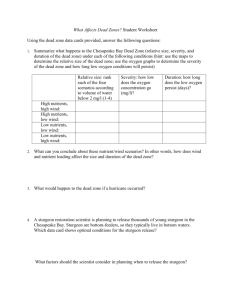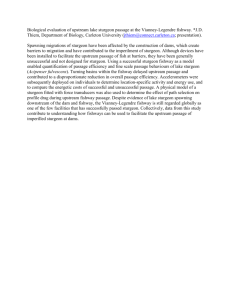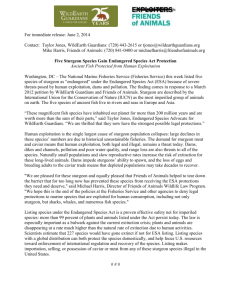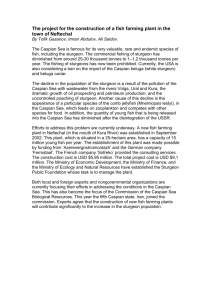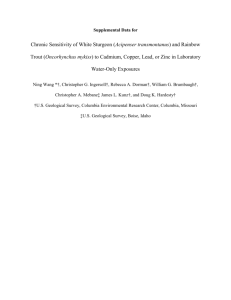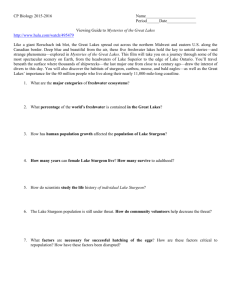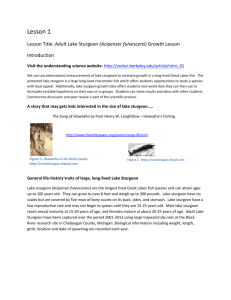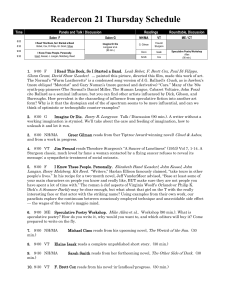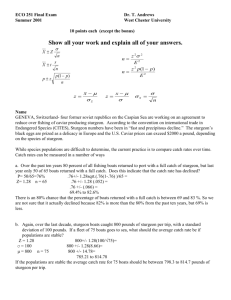Sturgeon Protection and Adaptive Management Program
advertisement
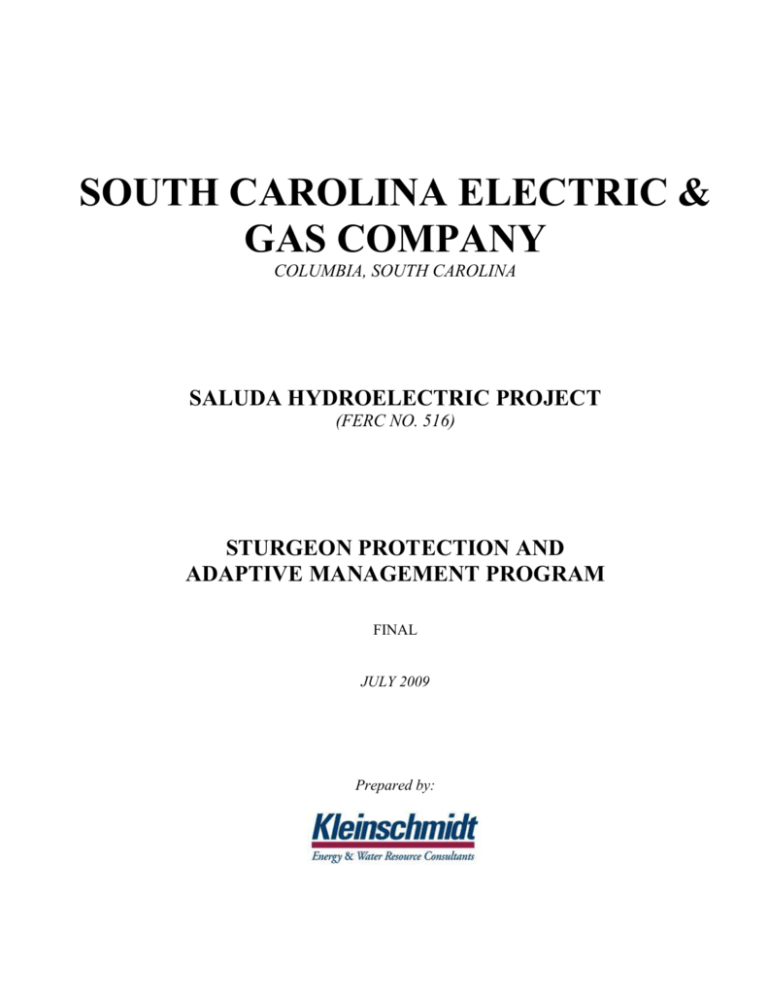
SOUTH CAROLINA ELECTRIC & GAS COMPANY COLUMBIA, SOUTH CAROLINA SALUDA HYDROELECTRIC PROJECT (FERC NO. 516) STURGEON PROTECTION AND ADAPTIVE MANAGEMENT PROGRAM FINAL JULY 2009 Prepared by: SOUTH CAROLINA ELECTRIC & GAS COMPANY COLUMBIA, SOUTH CAROLINA SALUDA HYDROELECTRIC PROJECT (FERC NO. 516) STURGEON PROTECTION AND ADAPTIVE MANAGEMENT PROGRAM FINAL JULY 2009 Prepared by: SOUTH CAROLINA ELECTRIC & GAS COMPANY COLUMBIA, SOUTH CAROLINA SALUDA HYDROELECTRIC PROJECT (FERC NO. 516) STURGEON PROTECTION AND ADAPTIVE MANAGEMENT PROGRAM FINAL TABLE OF CONTENTS 1.0 INTRODUCTION ...............................................................................................................1 2.0 BACKGROUND .................................................................................................................3 2.1 Shortnose Sturgeon Life History and Status ............................................................3 2.2 Atlantic Sturgeon Life History and Status ...............................................................4 2.3 Project Effects on Sturgeon and Other Diadromous Species...................................5 2.4 Relevant Studies Performed in Support of Relicensing ...........................................6 2.5 Santee River Basin Cooperative Diadromous Fish Accord .....................................7 3.0 PROTECTION AND ENHANCEMENT MEASURES .....................................................8 3.1 Downstream Dissolved Oxygen Enhancements ......................................................8 3.2 Implementation of Minimum Flows ........................................................................8 3.3 Establishment of a Sturgeon Technical Advisory Team..........................................9 3.4 Implementation of Agency-Recommended Studies ..............................................10 3.4.1 Study I: Sturgeon Behavior and Movements .............................................10 3.4.2 Study II: Temperature and Water Quality Monitoring Study ....................12 3.4.3 Study III: Habitat Characterization Study..................................................12 4.0 REPORTING .....................................................................................................................13 5.0 FUNDING..........................................................................................................................13 6.0 SCHEDULE .......................................................................................................................13 7.0 LITERATURE CITED ......................................................................................................14 LIST OF FIGURES Figure 1-1: Location Map for the Saluda Hydroelectric Project (FERC No. 516) .....................2 Figure 3-1: Receiver Array System Currently in Use...............................................................11 LIST OF TABLES Table 3-1: Summary or Proposed Minimum Flows for Lower Saluda River ...........................9 i SOUTH CAROLINA ELECTRIC & GAS COMPANY COLUMBIA, SOUTH CAROLINA SALUDA HYDROELECTRIC PROJECT (FERC NO. 516) FINAL STURGEON PROTECTION AND ADAPTIVE MANAGEMENT PROGRAM 1.0 INTRODUCTION The Saluda Hydro Project (Project) is a 202.6 megawatt (MW) hydroelectric facility owned and operated by South Carolina Electric & Gas (SCE&G or Licensee) and located on the Saluda River in Lexington, Newberry, Richland, and Saluda counties of South Carolina (Figure 1-1). The Project is currently licensed by the Federal Energy Regulatory Commission (FERC No. 516), and the present license is due to expire in the year 2010. SCE&G has been engaged with state and federal agencies, non-governmental organizations (NGO’s), and other stakeholders in a cooperative relicensing process for the Project since early 2005. The Final License Application to relicense the Project was filed with the FERC on August 27, 2008. In comments issued in response to SCE&G’s Draft License Application, NOAA Fisheries—National Marine Fisheries Service (NMFS) noted that Saluda and other Santee Basin projects potentially affect important historical spawning and maturation habitat for a number of diadromous fish species, including the federally endangered shortnose sturgeon and Atlantic sturgeon, a candidate for federal listing. NMFS also requested that SCE&G develop “practical and specific measures to mitigate continuing Project impacts” on these species. SCE&G subsequently consulted with NMFS, US Fish and Wildlife Service (USFWS), South Carolina Department of Natural Resources (SCDNR) and other stakeholders to cooperatively develop the Protection and Adaptive Management Program contained herein (See meeting notes, 17 October 20081 and 20 January 20092). Refers to joint meeting of all Fish and Wildlife Technical Working Committees (TWC’s), including: Diadromous Fish; Rare, Threatened and Endangered Species; Instream Flow and Aquatic Habitat; Freshwater Mussels and Benthic Macroinvertebrates; Fish Entrainment TWC’s. 2 Refers to conference call with NMFS and other resource agency staff. 1 1 Figure 1-1: Location Map for the Saluda Hydroelectric Project (FERC No. 516) 2 2.0 BACKGROUND 2.1 Shortnose Sturgeon Life History and Status Much of the Santee Basin, including the portion of the Saluda Basin encompassed by the Project, is thought to be within the historic range of the shortnose sturgeon (Welch, 2000; Newcomb and Fuller; 2001). In the Santee Basin, the shortnose sturgeon is believed to be amphidromous, migrating between freshwater and mesohaline reaches, and ascending to inland riverine reaches on annual spawning runs (NMFS, 1998a; Buckley and Kynard, 1985; Kynard, 1997). In northern rivers, migratory spawning runs of this species usually occur in early February to mid-March when water temperatures approach 9-14°C (Kynard, 1997). In southern rivers, spawning runs may occur as late as mid-April (S. Bolden, NMFS, Personal Communication, 2007). Shortnose sturgeon spawning has been documented in the Congaree River near Columbia over substrates of sand, gravel and rock, at temperatures ranging from 9.7-15.6°C, and dissolved oxygen concentrations of 10.6-12.5 mg/L (Collins et al., 2003). Shortly after spawning, shortnose sturgeon larvae begin movements downstream, and young of the year may remain in freshwater reaches for their first year of life before moving downstream as juveniles to lower river reaches near the saltwater interface (Kynard, 1997). Population groups of shortnose sturgeon are known from downstream of the Santee-Cooper dams (lakes Marion and Moultrie) in the lower reaches of the SanteeCooper basin (Collins et al., 2003). An additional dam-locked spawning population of shortnose sturgeon has been documented within and upstream of the Santee-Cooper Lakes, with Lake Marion and its tributaries harboring the most significant population and an upstream spawning site located in the upper Congaree River. Radio-telemetry studies conducted by the SCDNR have documented migration of Lake Marion shortnose sturgeon as far upstream as the Gervais Street Bridge on the Congaree River, which is adjacent to the City of Columbia and just downstream of the confluence of the Broad and Saluda rivers (J. Gibbons, SCDNR, Pers. Comm.). NMFS considers the potential present range of shortnose sturgeon to include all accessible waters below the Saluda, Wateree, and Columbia Dams (P. Brownell, NMFS, Personal communication). 3 2.2 Atlantic Sturgeon Life History and Status The Atlantic sturgeon is a large (up to 5.5m), long-lived (up to 60 years) anadromous species native to Atlantic Coast drainages from Labrador to Florida (Marcy et al., 2005). Atlantic sturgeon is currently considered by the USFWS as a candidate for federal listing as threatened or endangered (71 R 61022). Stocks of the species are considered imperiled, primarily due to overharvesting for flesh and eggs (caviar) during the early—to—mid—20th Century, and secondarily, due to habitat degradation and blockage of access to historical spawning grounds (NMFS, 1998b). In the Santee Basin, Atlantic sturgeon was historically present at least as far inland as the fall line (Newcomb and Fuller, 2001). The Atlantic sturgeon is considered estuarine anadromous, spending most of it life in estuarine and ocean environments and undertaking spawning migrations into riverine systems during late-winter and spring months (NMFS, 1998b; Marcy et al, 2005). In southeastern rivers, female Atlantic sturgeon reach sexual maturity at age 7 to 19 and spawn only once in a 2 to 6 year period (NMFS, 1998b). Males of the species reach maturity between age 8 and 12 years (Marcy et al., 2005). Spawning typically occurs over hard bottoms of clay, rubble, or gravel, with running water and temperatures of 14 24°C. After spawning, females typically return to estuarine environments within 4 to 6 weeks, while males may remain in the river through the fall. Juveniles of this species remain in the natal rivers for 3 to 5 years before migrating to the ocean (Marcy et al., 2005). The status of Atlantic sturgeon upstream from the Santee Cooper Dams is uncertain; however, three adults have been recovered upstream from the dams in recent years (P. Brownell, NMFS, Pers. Comm.). Like shortnose sturgeon, Atlantic sturgeon was historically present at least as far inland as the fall line (Newcomb and Fuller, 2001). Current upstream distribution in the Santee Basin is likely limited by the lack of passage for Atlantic sturgeon at the Santee Cooper Dams (P. Brownell, NMFS, Pers. Comm.). As with shortnose sturgeon, NMFS considers the potential present range of Atlantic sturgeon 4 to include all accessible waters below the Saluda, Wateree, and Columbia Dams (P. Brownell, NMFS, Personal communication). 2.3 Project Effects on Sturgeon and Other Diadromous Species Construction and operation of the Saluda Project since its construction in the 1930’s has resulted in blockage of access to many river miles of former spawning and maturation habitats above the Lake Murray Dam, permanent loss of riverine habitat by reservoir inundation, and alteration of natural flows, temperature, and dissolved oxygen in the lower Saluda and Congaree Rivers (Columbia Shoals). Hypolimnetic flows from the Lake Murray Dam have depressed seasonal ambient dissolved oxygen levels and temperatures in the lower Saluda River for decades, potentially playing a role in the observed absence of diadromous species including sturgeon, striped bass, American shad, and American eel. In recent years dissolved oxygen levels in the Saluda have been substantially improved through installation of turbine runner hub baffles and changes in hydro operations. Because of the lower ambient temperatures in the lake Murray Dam flow releases, trout were introduced in the 1960’s to provide a “put and take” fishery which has become popular and of economic importance to the public and state fishery management objectives for the Saluda River. Active management of the Saluda River as a cold-water fishery for trout provides significant public fishery benefits, and reduces habitat suitability for potential restoration of natural resident aquatic species and migratory diadromous fish. According to NMFS, development of practical actions for mitigation of continuing project effects on diadromous species is limited by the size and depth of the Lake Murray Dam and reservoir, limited options for effective fish passage, hydropower generation operations, and established management of the lower Saluda River for a coldwater trout fishery. 5 2.4 Relevant Studies Performed in Support of Relicensing Sturgeon Survey of Lower Saluda and Upper Conagree Rivers In response to anadromous fish studies requested by the NMFS and SCDNR during the initial stages of the Saluda Project relicensing, SCE&G developed and implemented a Shortnose Sturgeon Study Plan (Kleinschmidt, 2006). The primary objective of this study was to document whether or not shortnose sturgeon are utilizing areas of the lower Saluda and upper Congaree rivers downstream of the Project. Implemented during the 2007 migratory season, the study included gillnet sampling for adult and juvenile sturgeon, as well as D-net samples for eggs and larvae, at four downstream locations: two in the lower Saluda and two in the upper Congaree (immediately upstream and downstream of the Granby Lock and Dam). Approximately 400 hours of gillnetting during the 2007 season resulted in no captures of adult or juvenile sturgeon; likewise, no eggs or larval sturgeon were captured during the sampling period (Kleinschmidt, 2007). Lower Saluda and Upper Conagree Rivers Temperature Study At the request of the USFWS (letter dated August 1, 2005), SCE&G developed and executed a downstream water temperature study during 2006 and 2007 as part of relicensing (Kleinschmidt, 2008). The study objective was to characterize the effects of water releases from the Project Dam on the temperature regime of the LSR and Congaree River, including downstream extent of temperature alteration, timing and duration of temperature alteration, and mixing characteristics. Paired temperature sensors (left and rights side of the channel) were deployed at 7 locations along an approximately 55 mile reach of the LSR and Congaree River downstream of Saluda Hydro (extending from the Riverbanks Zoo on the LSR to the Highway 601 Bridge on the Congaree). Project releases were found to result in cross-sectional differences in water temperature in the Congaree River downstream of the confluence, with the LSR side of the channel being significantly cooler than the Broad River side. Study results suggested that Broad and 6 Saluda waters were not completely mixed (from a temperature perspective) until approximately 16 miles below the confluence. NMFS has noted that the altered thermal regime in the LSR and upper Congree potentially impacts current and/or historic spawning and maturation habitat for shortnose and Atlantic sturgeon, as well as other diadromous species. 2.5 Santee River Basin Cooperative Diadromous Fish Accord Along with USFWS, SCDNR, North Carolina Wildlife Resources Commission (NCWRC), and Duke Energy, SCE&G is a signatory and funder of the Santee River Basin Accord for Diadromous Fish Protection, Restoration, and Enhancement (Accord). The purpose of this Accord is to collaboratively address diadromous fish protection, restoration and enhancement in the Santee River Basin through implementation of a 10year action plan. The Accord will remain in effect through the duration of the new license for the Saluda Hydro Project. As currently proposed, the Accord would fund a number of diadromous fish studies in the basin as part of the 10—year Action Plan, including five years of sturgeon research. 7 3.0 PROTECTION AND ENHANCEMENT MEASURES 3.1 Downstream Dissolved Oxygen Enhancements SCE&G proposed in its Final License Application for Saluda Hydro (filed with the FERC on August 27, 2008) to continue turbine aeration measures implemented since 1999 aimed at optimizing DO in Project releases. Specifically, these measures included installation of turbine venting and hub baffles on Project turbines (completed in 1999 and 2005, respectively), as well as implementation of operational modifications (“look-up tables”) developed in recent years to provide guidance regarding unit and gate combinations that provide the greatest DO enhancement under various operating scenarios. These measures have resulted in significant DO improvements in the LSR, with median DO in Project releases increasing from 2.7 mg/L before 1999 to 7.2 mg/L after implementation (1999 to 2007). Likewise, this has resulted in less frequent occurrences of DO levels in the release below 5.0 mg/L, from 88% to about 12% of the time. SCE&G has also elected to install new turbine runners during the life of the new license for the Project. The proposed turbine runners will be of modern design that offer higher efficiencies, output and DO uptake. While providing for enhanced unit efficiency and maintaining the reliability to generation obligations, the upgrade of the existing unit runners will provide positive benefits for downstream DO levels such that 100% support of the SCDHEC in-stream DO standard may be assured. 3.2 Implementation of Minimum Flows SCE&G has also proposed to implement minimum flow releases from Saluda Hydro to support target riverine species in the LSR, including sturgeon. In addition to improved DO conditions (through increased shoaling and turbulence), implementation of minimum flows will likely improve sturgeon habitat by ensuring more stable flows and by providing depths and velocities that better match the sturgeon habitat requirements. 8 Physical Habitat Simulation (PHABSIM) modeling conducted in support of relicensing suggested that the 1000 cfs minimum flow being proposed for the spring months during a normal water year will provide approximately 60% of maximum Weighted Usable Area (an estimate of available habitat) for shortnose sturgeon. Further, PHABSIM modeling suggested that sturgeon habitat would likely be enhanced by even higher flows, suggesting that the targeted striped bass flows that are part of the minimum flow regime would provide additional enhancement for sturgeon. Table 3-1: Summary or Proposed Minimum Flows for Lower Saluda River TIME PERIOD January 1—March 31 FLOW (cfs) 700 April 1—May 10 1,000 plus SCDNR striped bass spawning flows3 May 11—May 31 1,000 June 1—December 31 3.3 700 Establishment of a Sturgeon Technical Advisory Team Under a new FERC license for the Saluda Project, SCE&G will establish a Sturgeon Technical Advisory Team (STAT) consisting of the following agencies in addition to the Licensee: US Fish and Wildlife Service (USFWS), South Carolina Department of Natural Resources (SCDNR) and NMFS. The initial purpose of the STAT will be to collaboratively participate in design and implementation of the sturgeon study program outlined below in Section 3.4. 3 The striped bass enhancement flows are intended to improve conditions for striped bass spawning in the Congaree River, which is formed by the confluence of the Broad and Saluda Rivers. From April 1st – May 10th annually, striped bass target flows will be implemented as a daily target when the previous day’s daily average flow in the Broad River (measured at Alston gage) is between 2,500 CFS and 8,000 CFS. On such days, Saluda will release a continuous target flow equal to the lesser of (+/- 100 cfs): (1) 45% of the previous day’s daily average flow in the Broad River at the Alston gage or (2) The balance of what is required to create a 9,000 CFS in the Congaree River. Additional detail regarding the striped bass enhancement flows is provided in the Saluda Hydro Relicensing Settlement Agreement. 9 Following completion of the sturgeon study program outlined in Section 3.4, the STAT will integrate the findings of Studies I-III to identify Saluda Project-specific effects and limiting factors, and other limiting factors affecting sturgeon recovery in the study area. To the extent possible, the STAT will then identify practical beneficial actions that can be undertaken to contribute positively to recovery of sturgeon in the Santee River Basin. 3.4 Implementation of Agency-Recommended Studies Under a new FERC license for the Saluda Project, SCE&G will recommend to the Santee Basin Accord Board that the Studies I and II outlined below be implemented during the initial 5-years of Accord sturgeon studies. In consultation with the STAT, SCE&G will review the results of the 5-year Accord study period to determine whether the Project-specific objectives of Studies I and II have been met. If it is determined that the Accord studies do not adequately address the Project-specific objectives of Studies I and II, SCE&G will consult directly with the STAT to ensure that the study objectives are met outside of the Accord process. In the event that Atlantic or shortnose sturgeon are documented in the LSR, SCE&G will also implement Study III as outlined below. Similar to studies I and II, Study III would be implemented through the ACCORD process or independently in consultation with the NMFS, USFWS and SCDNR. 3.4.1 Study I: Sturgeon Behavior and Movements Purpose: Monitor sturgeon behavior and movements to improve understanding of habitat use patterns in response to river flow regulation, short term and seasonal temperature and dissolved oxygen variations, and availability of suitable habitat in the Saluda, lower Broad, and Congaree Rivers. Improved understanding of factors limiting recovery of sturgeon and other diadromous species is expected to support practical adaptive management actions. 10 Methods: Conduct a telemetry study to monitor movements of sturgeon in the Congaree, lower Broad, and Saluda Rivers, in concert with other telemetry studies in the Santee River Basin. This objective will be achieved by using a receiver array system already in place and in use (Figure 3-1). Recommendations would be for a 5-year study with annual review of study findings and assessment of factors affecting sturgeon recovery. Figure 3-1: Receiver Array System Currently in Use 11 3.4.2 Study II: Temperature and Water Quality Monitoring Study Purpose: Establish a temperature and water quality monitoring program to help develop a better understanding of physical habitat factors potentially affecting movements, migrations, spawning, and recovery of sturgeon and other diadromous and resident species of special management interest. Study area should include the Saluda River, lower Broad River, and the Congaree River. Methods: Establish an array of temperature and water chemistry monitoring stations located throughout the study area to allow for automated data collection and analysis. Data analysis should help identify annual and seasonal variations in temperature throughout the study area using GIS spatial analysis tools. An initial 5-year study should be planned with annual review of study findings and assessment of environmental factors actually or potentially affecting sturgeon recovery. 3.4.3 Study III: Habitat Characterization Study Purpose: If Atlantic or Shortnose sturgeon are found in the LSR during Study I, integrate the findings of Studies I and II with a detailed physical habitat study to identify, characterize and map habitats in the lower Saluda, lower Broad, and Congaree Rivers to provide support for a long term sturgeon recovery program in the Santee River Basin. Identify potential critical habitats and limiting factors. Approach/Methods: Conduct a field study to characterize, classify, and map important habitat components in the study area including substrate type, depth/velocity characteristics, location of point source discharges, seasonal temperature and dissolved oxygen distribution, etc. Plan for a one-year initial physical habitat characterization study, with provisions to adapt the habitat characterization based on findings of Studies I and II. 12 4.0 REPORTING A report detailing study results and conclusions will be prepared and filed with the FERC annually after each study year during the 5-year sturgeon study period conducted as part of the Accord. A draft report will be submitted to the agencies participating in the STAT a minimum of 30 days prior to the report being filed with the FERC. Any additional reporting requirements will be determined based on consultation with the state and federal resource agencies. 5.0 FUNDING To the extent possible, the sturgeon study program outlined above in Section 3.4 will be funded through the monies already allocated to sturgeon research as part of the Santee Basin Diadromous Fish Accord. Any additional activities or studies deemed necessary in consultation with the STAT to meet the project-specific objectives of the agency-requested studies outlined in Section 3.4 will be funded by SCE&G or other funding sources deemed appropriate in consultation with the resource agencies. 6.0 SCHEDULE The sturgeon study program outlined in Section 3.4 will be implemented following issuance of a new license for the Saluda Project and in accordance with the Accord schedule. The Sturgeon Technical Advisory Team (STAT) (Section 3.3) will be convened a minimum of six months prior to SCE&G recommending any studies for implementation under the Accord. This will provide the STAT enough time to develop the list of studies they would like to have conducted as part of the Accord. 13 7.0 LITERATURE CITED Buckley, J., and B. Kynard. 1985. Yearly movements of shortnose sturgeons in the Connecticut River. Transactions of the American Fisheries Society 114:813–820. Collins, M. R., D. W. Cooke, B. Post, J. Crane, J. Bulak, T. I. J. Smith, T. W. Greig, and J. M. Quattro. 2003. Shortnose sturgeon in the Santee Cooper Reservoir system, South Carolina. Transactions of the American Fisheries Society 132:1244–1250. Kleinschmidt Associates. 2006. Saluda Project Relicense: Shortnose Sturgeon Study Plan. Prepared for South Carolina Electric & Gas Co. January 2006. 9 pp. Kleinschmidt Associates. 2007. Lower Saluda River and Upper Congaree River Shortnose Sturgeon Sampling: 2006 Final Report. Lake Murray Wood Stork Surveys: 2006 Summary Report. Prepared for South Carolina Electric & Gas Co. Kleinschmidt Associates. 2008. Saluda Hydroelectric Project: Downstream Temperature Study Final Report. Prepared for South Carolina Electric & Gas Co. Kynard, B. 1997. Life history, latitudinal patterns, and status of the shortnose sturgeon, Acipenser brevirostrum. Environmental Biology of Fishes 48: 319-334. Marcy, B.C., Jr., D.E. Fletcher, F.D. Martin, M.H. Paller, M.J.M. Reichert. 2005. Fishes of the Middle Saluda River Basin. University of Georgia Press, Athens, GA. 461 pp. National Marine Fisheries Service (NMFS). 1998a. Recovery plan for the shortnose sturgeon (Acipenser brevisrostrum). Prepared by the Shortnose Sturgeon Recovery Team for the NMFS, Silver Spring, Maryland. 104 pp. National Marine Fisheries Service (NMFS). 1998b. Fishery Management Report No. 31 of the Atlantic States Marine Fisheries Commission. Amendment 1 to the Interstate Fishery Management Plan for Atlantic sturgeon (Acipenser oxyrhynchus oxyrhynchus). July 1998. 43 pages. Newcomb, T.J. and J.S. Fuller. 2001. Anadromous and Catadromous Fish Survey of Santee/Cooper Basin in North Carolina and South Carolina. Department of Fisheries and Wildlife Sciences, Virginia Polytechnic Institute and State University, Blacksburg, VA. Final Report, Prepared for Duke Power, June 25, 2001. 25 pp. 14 Welch, S.M. 2000. A Report on the Historical Inland Migrations of Several Diadromous Fishes in South Carolina Rivers. Department of Aquaculture, Fisheries and Wildlife, Clemson University, Clemson, SC. Report prepared for Mr. Douglas W. Cook, South Carolina Department of Natural Resources. December 4, 2000. 19 pp. 15
